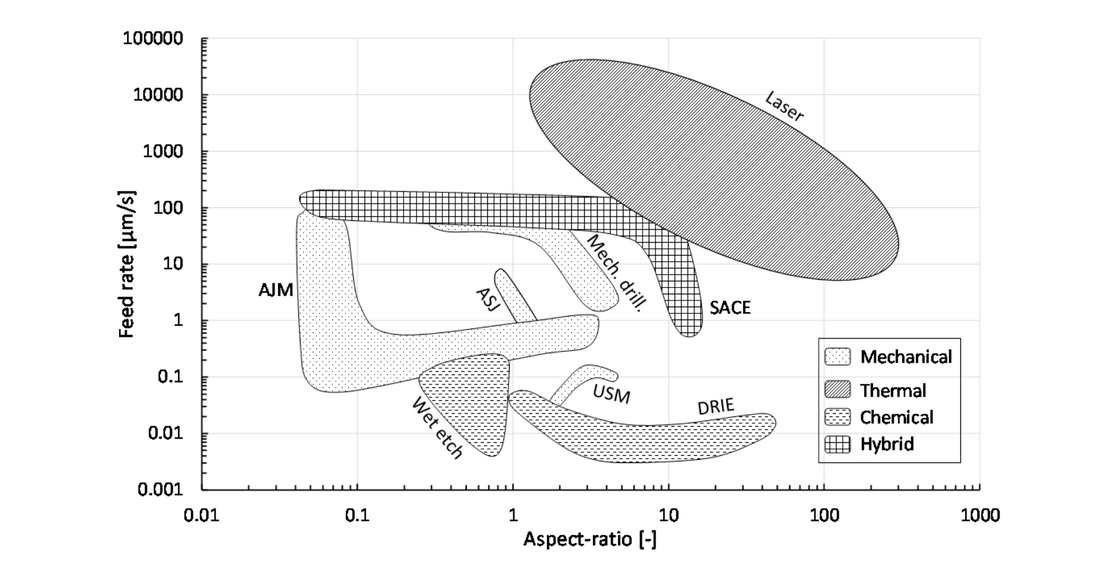
유리 기판의 마이크로홀 드릴링 - 리뷰
소환
Hof, LA, & Ziki, JA (2017). 유리 기판의 마이크로홀 드릴링 - 리뷰. Micromachines , 8 (2), 53. https://doi.org/10.3390/mi8020053
키워드
- 마이크로 드릴링 기술
- 유리
- 마이크로 디바이스
- 마이크로유체학
- 멤스
짧은
본 논문은 유리에 미세구멍을 뚫기 위한 기존 기술과 새로운 기술을 검토한 것입니다.
요약
Micromachines 저널의 이 기사는 유리에 미세 구멍을 뚫는 다양한 방법을 검토합니다. 유리는 무선 주파수에 투명하고 유리한 광학적, 기계적, 화학적 특성을 가지고 있기 때문에 마이크로 디바이스에 유용한 재료입니다. 그러나 유리는 또한 취성이 있고 기계 가공이 어려워서 매끄럽고 높은 종횡비의 유리 관통 비아(TGV)를 뚫는 것이 어렵습니다.
이 리뷰 기사는 유리에 미세 구멍을 뚫기 위한 기존 기술과 새로운 기술을 요약하고 비교하여 4가지 범주로 그룹화합니다.
- 기계적 방법: 이러한 방법은 일반적으로 저렴하지만 거친 표면을 초래할 수 있습니다. 여기에는 다음이 포함됩니다.
- 기계적 드릴링: 회전하는 도구로 재료를 제거하는데, 종종 쪼는 동작을 사용하여 파편을 제거합니다. 기계적 드릴링은 비용 효율적이고 신속한 프로토타입 제작에 좋지만 균열이 생길 수 있습니다.
- 파우더 블라스팅: 재료를 제거하기 위해 고속의 연마 입자 흐름을 사용합니다. 파우더 블라스팅은 빠르고 버, 미세 균열 또는 열 영향 구역(HAZ)을 생성하지 않습니다. 그러나 거친 표면이 발생합니다.
- 초음파 드릴링: 연마 슬러리가 있는 진동 도구를 사용하여 재료를 침식합니다. 높은 종횡비와 직선 벽을 가진 작은 구멍을 만들 수 있지만 느리고 도구 마모가 심하며 깨짐과 균열이 발생할 수 있습니다.
- 열적 방법: 이러한 기술은 빠른 속도에서 높은 종횡비를 달성할 수 있지만, 표면 품질이 낮아질 수도 있습니다. 열적 방법에는 다음이 포함됩니다.
- 레이저 가공: 레이저를 사용하여 재료를 제거합니다. 레이저 가공은 유연하고 처리량이 높지만 HAZ를 생성하고 파편을 재주조하여 본딩을 어렵게 만들 수 있습니다. CO2, 엑시머, 액체 지원, PDMS 마스크, 초단 펄스 레이저와 같은 다양한 유형의 레이저와 기술은 다양한 장단점을 제공합니다.
- 화학적 방법: 이 방법은 에칭제를 사용하여 유리를 용해합니다. 표면 품질을 좋게 할 수 있지만 느리고 여러 단계와 특수 장비가 필요할 수 있습니다. 예를 들어 다음과 같습니다.
- 습식 에칭: 작업물을 화학 에칭제, 일반적으로 불산(HF)에 담그는 과정입니다. 이 등방성 공정은 둥근 측벽을 생성하고 매끄러운 표면을 가진 작은 형상을 생산할 수 있지만, 종횡비가 낮고 핀홀과 노치 결함이 발생할 위험이 있습니다.
- 심층 반응성 이온 에칭(DRIE): 플라즈마를 사용하여 유리를 화학적, 물리적으로 에칭하는 이온을 생성합니다. 높은 종횡비와 매끄러운 표면이 가능하지만 DRIE는 에칭 속도가 느리고 특정 마스크가 필요합니다.
- 하이브리드 방식: 이러한 방식은 두 가지 이상의 기술을 결합하여 성능을 개선하거나 제한을 극복합니다. 이 범주에는 다음이 포함됩니다.
- 보조 하이브리드 미세 가공: 다른 형태의 에너지를 사용하여 기본 가공 프로세스를 수정하거나 향상시키는 것을 포함합니다. 이 범주의 기술에는 진동 보조 미세 가공, 레이저 보조 미세 절단, 레이저 유도 플라즈마 미세 가공(LIPMM), 물 보조 미세 가공, 화학 보조 미세 가공, 화학 보조 초음파 가공(CUSM), 전기유변(ER) 유체 보조 초음파 가공, 보조 전극이 있는 EDM 및 핫 엠보싱이 포함됩니다.
- 복합 하이브리드 마이크로머시닝: 여러 가공 메커니즘의 동시 작동을 포함합니다. 이것의 한 예는 알칼리성 용액에서 전기 방전을 사용하여 재료를 제거하는 스파크 지원 화학 조각(SACE)입니다. SACE는 비교적 매끄러운 표면으로 높은 종횡비를 생성할 수 있지만 가공 속도가 느리고 파편의 세척이 제한될 수 있습니다.
이 기사는 마이크로홀 드릴링 기술의 선택은 응용 분야의 특정 요구 사항에 따라 달라지며, 종횡비, 표면 품질, 속도 및 비용 간에 필요한 절충이 필요하다고 결론지었습니다. 특히 하이브리드 방법은 다양한 기술의 강점을 결합하여 원하는 결과를 달성할 수 있는 유망한 방법을 제공합니다.
